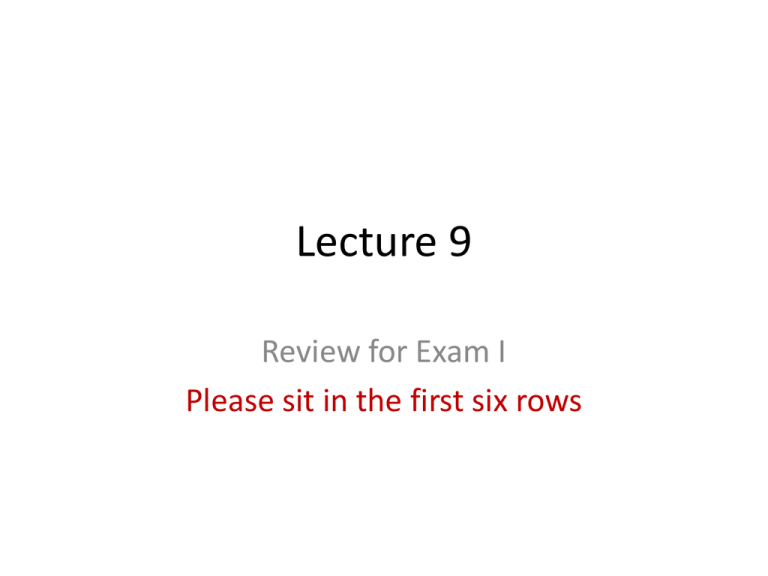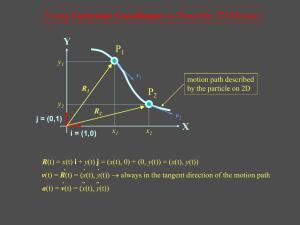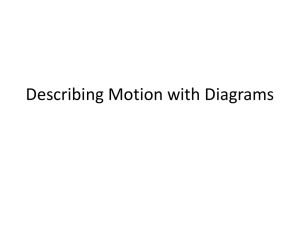Lecture 9 Monday Sept 15x
advertisement

Lecture 9 Review for Exam I Please sit in the first six rows Are you here today? 93% No 7% Ye s 1. Yes 2. No Exam 1 Review • Chapter 1 motion diagrams, unit conversion • Chapter 2 motion in 1-dimension, constant velocity, constant acceleration 1. What is the difference between speed and velocity? A. Speed is an average quantity while velocity is not. B. Velocity contains information about the direction of motion while speed does not. C. Speed is measured in mph, while velocity is measured in m/s. D. The concept of speed applies only to objects that are neither speeding up nor slowing down, while velocity applies to every kind of motion. E. Speed is used to measure how fast an object is moving in a straight line, while velocity is used for objects moving along curved paths. Slide 1-2 Chapter 1 • Particle model of an object in motion If Sam walks 100 m to the West, then 200 m to the South, his net displacement vector has a magnitude of _________ and makes an angle of ________ with respect to the x-axis Slide 1-6 Checking Understanding Two runners jog along a track. The positions are shown at 1 s time intervals. Which runner is moving faster? Slide 1-18 Speed and Velocity Velocity is a vector ! Problem • Alice is sliding along a smooth, icy road on her sled when she suddenly runs headfirst into a large, very soft snowbank that gradually brings her to a halt. Draw a graph of her velocity versus time and her position versus time. 1. The slope at a point on a position-versus-time graph of an object is A. the object’s speed at that point. B. the object’s average velocity at that point. C. the object’s instantaneous velocity at that point. D. the object’s acceleration at that point. E. the distance traveled by the object to that point. F. Homework Problem 2: 21 Slide 2-3 The area under a velocity-versus-time graph of an object is A. the object’s speed at that point. B. the object’s acceleration at that point. C. the distance traveled by the object. D. the displacement of the object. E. This topic was not covered in this chapter. F. Homework question 2.14 and 15 Slide 2-5 Acceleration Free Fall m a y g 9.80 2 s Free Fall a y g constant v y (t ) viy gt 1 2 y (t ) yi viy t gt 2 Examples Spud Webb, height 5'7", was one of the shortest basketball players to play in the NBA. But he had an impressive vertical leap; he was reputedly able to jump 110 cm off the ground. To jump this high, with what speed would he leave the ground? A football is punted straight up into the air; it hits the ground 5.2 s later. What was the greatest height reached by the ball? With what speed did it leave the kicker’s foot? Passengers on The Giant Drop, a free-fall ride at Six Flags Great America, sit in cars that are raised to the top of a tower. The cars are then released for 2.6 s of free fall. How fast are the passengers moving at the end of this speeding up phase of the ride? If the cars in which they ride then come to rest in a time of 1.0 s, what is acceleration (magnitude and direction) of this slowing down phase of the ride? Given these numbers, what is the minimum possible height of the tower? Slide 2-31 Additional Examples When you stop a car on icy pavement, the acceleration of your car is approximately –1.0 m/s². If you are driving on icy pavement at 30 m/s (about 65 mph) and hit your brakes, how much distance will your car travel before coming to rest? As we will see in a future chapter, the time for a car to come to rest in a collision is always about 0.1 s. Ideally, the front of the car will crumple as this happens, with the passenger compartment staying intact. If a car is moving at 15 m/s and hits a fixed obstacle, coming to rest in 0.10 s, what is the acceleration? How much does the front of the car crumple during the collision? Slide 2-38 Vector Components Ax A cos y Ay A sin A Ay θ Ax x Given A and θ we found Ax and Ay Given Ax and Ay, find A and θ y A Ax 2 Ay 2 Ay tan Ax 1 Ay θ Ax x Adding vectors numerically C A B Cx Ax Bx C y Ay By Also called algebraic addition What would subtraction look like? Scalar multiplication?











